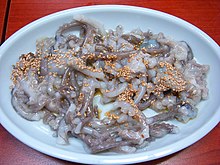Sannakji: Live Octopus Becomes an Iconic Korean Dish
History of Sannakji: A Legendary Traditional Dish
Sannakji: Live Octopus Becomes an Iconic Korean Dish – Sannakji is one of Korea’s traditional dishes known for its uniqueness. This dish uses live octopus or fresh octopus pieces that are still moving as its main ingredient. The tradition of serving sannakji has been going on for centuries and is often associated with Korea’s rich maritime culture.
Coastal communities in Korea have abundant access to fresh Seafood, including octopus. This encourages the habit of enjoying seafood at its freshest. Sannakji is considered a symbol of freshness because the octopus used is usually caught and served on the same day. This practice reflects the simple lifestyle of coastal communities that are highly dependent on the sea.
In addition, sannakji also has its own philosophy in Korean culture. This dish reflects a person’s courage and skill in enjoying food. The sensation of tentacles that are still moving in the mouth provides a unique and challenging culinary experience, so it is often an attraction for tourists who want to experience local culture directly.
In some traditional events, sannakji is also served as a symbol of respect for special guests. Serving live octopus is considered a form of appreciation for the guest’s courage in trying an unusual dish. However, due to the risks, sannakji is usually only served by experienced chefs who understand safe cooking techniques.
Over time, sannakji has become known not only as an everyday food, but also as a cultural attraction that illustrates the uniqueness of Korean culinary traditions.
Unique and Bold Ways of Serving Sannakji
Sannakji is known as one of the most unique and extreme dishes in Korean culinary tradition. This dish uses live octopus or small pieces of fresh octopus tentacles served directly after being cut. The uniqueness of sannakji lies in the tentacles that are still moving on the plate, providing an extraordinary visual experience and eating sensation.
The process of serving sannakji begins with selecting fresh octopus. The octopus used is usually small to medium in size to maintain a chewy texture and sweet taste. After being caught, the octopus is immediately cleaned, cut into pieces, and served quickly to ensure that the tentacles remain actively moving.
This dish is usually served with sesame oil mixed with a little salt or sesame seeds. Sesame oil provides a distinctive aroma and adds a savory taste that complements the chewy texture of the octopus. In some cases, sannakji is also served with spicy gochujang sauce to give a stronger touch of flavor.
When enjoying sannakji, visitors are advised to chew well because the octopus tentacles still have strong suction power. This is part of the appeal and challenge for those who try this dish for the first time. This unique way of serving sannakji has made it an icon of Korean cuisine, often sought out by tourists who love extreme food.
For locals, enjoying sannakji is not just about the taste, but also a symbol of courage and the ability to enjoy fresh seafood in its most natural state. This dish reflects the close connection between Korea’s maritime culture and its traditional lifestyle.
Choking Risk: The Dangers Behind the Deliciousness of Sannakji
Sannakji, a Korean specialty dish featuring live octopus pieces, is renowned for its uniqueness. However, behind this culinary appeal lies a choking risk that cannot be ignored. The moving octopus tentacles have a natural suction power, which can stick to the mouth or throat if not chewed properly.
This risk is especially high for those who are inexperienced or in a hurry when enjoying it. The chewy and slippery texture of the octopus also adds to the challenge when chewing. Too large pieces of tentacles can increase the possibility of choking, especially if the suction power of the tentacles is still active.
To reduce this risk, it is important to cut the tentacles into small pieces and chew them thoroughly before swallowing. Many restaurants serve sannakji carefully by ensuring that each piece is easy to consume. In addition, visitors are often advised to drink water or other beverages as an accompaniment to help the swallowing process.
Children, the elderly, or anyone with certain medical conditions such as difficulty swallowing, should avoid trying sannakji. While the thrill of eating sannakji is considered a thrilling experience, safety is still a top priority.
In Korea, sannakji is often served by experienced chefs who ensure that it is prepared and served properly. However, for tourists or newcomers, it is important to understand these potential dangers before trying this challenging dish.
Safe Tips for Enjoying Sannakji Without Worry
Sannakji, a Korean live octopus dish, offers a unique culinary experience but also carries the risk of choking. To ensure a safe dining experience, here are some important tips to keep in mind before trying this extreme dish.
Choose a trusted restaurant that has a good reputation for serving sannakji. Experienced restaurants usually ensure that the tentacle pieces are small and easy to consume. This is very important to reduce the risk of the tentacles’ suction power still being active.
Make sure you chew the tentacles well before swallowing them. The thorough chewing motion helps break up the octopus fibers and reduces the risk of the tentacles getting stuck in your throat. Avoid rushing, and enjoy each piece slowly.
Avoid taking tentacle pieces that are too big. Small sizes are not only safer but also allow you to enjoy the texture and taste of sannakji more easily. If you are unsure, ask the restaurant staff for advice on how to enjoy this dish.
Drink water or other beverages as an accompaniment to help with the swallowing process. Drinks can help release the tentacles’ suction power if there is any obstruction. However, make sure not to rely too much on liquids to avoid additional difficulties.
For beginners, it is recommended to try sannakji with an experienced friend. In addition to being more fun, your friend can give you first-hand tips on how to eat safely. If you are in doubt, ask the restaurant staff about the correct eating technique before you start tasting.
With proper preparation and caution, you can enjoy sannakji without any worries. This dish is not only about courage but also about a memorable experience.




